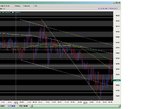Fibonacci Numbers:
I wont go into the history of who he was etc, as this info can be gleaned elsewhere. Nor will I go into the ubiquity of the Golden Mean.
The numbers are derived by taking the numbers 0 and 1, and then adding the latest two numbers to derive the next number.
For example, 0 + 1 = 1. ( the sequence is now 0, 1, 1 )
Now add the last two numbers, 1 + 1 = 2. ( the sequence is now 0, 1, 1, 2 )
Now add the last two numbers again, 1 + 2 = 3. ( the seq is now 0,1,1,2,3 )
One more time !! ( 2 + 3 = 5 ) this gives, 0,1,1,2,3,5.
This can go on indefinitely. Since T2W doesn’t possess that amount of web-storage, the next few numbers are:
0, 1, 1, 2, 3, 5, 8, 13, 21, 34, 55, 89 etc
Now, if you divide each consecutive number, the further along the sequence you are, the result tends to the famous Golden Mean, which is about 1.618, and its complement, 0.618.
For example, 2 / 3 = 0.667. 3 / 2 = 1.5.
For example, 3 / 5 = 0.6. 5 / 3 = 1.667.
For example, 21 / 34 = 0.6176. 34 / 21 = 1.619.
As you can see, the further up the sequence, the closer the results are to these 2 numbers.
The square root of 1.618 is 1.272.
The square root of 0.618 is 0.786.
So as I don’t get carried away, I am not going to use the 38% figure.
( it is derived by squaring 0.618. ( 0.618 * 0.618 = 0.3819 )
The main reason for this, is to start with the basics, and build on these basics.
If contributors feel strongly about some retracements, and can make a good case, then we should adopt them. Otherwise, it is best to prove the basics, before adding more lines.
I am concerned that if we throw enough lines onto a chart, we can prove anything !!
So, to start with, I suggest the following 4 percentages are of note:
62% ( rounded from 0.618 )
79% ( rounded from 0.786 )
127% ( rounded from 1.272 )
162% ( rounded from 1.618 )
I will take advice from the readers as to whether 50% retracement is valid.
( actually, it probably is, but can the 50% retracement be derived in the context of Fibonacci ? )
This is my understanding of Fibonacci numbers.
I propose the above as a starting place for further analysis.
In the context of trading, markets appear to change direction, or make retracements on these particular percentages. Perhaps more often than other percentages.
If the above is a satisfactory basis, I propose to see how all this can be applied to the markets.
( hopefully there will be contributors with experience of stocks, as my trading vehicles tend to be indices, DOW, SP500, DAX etc )

